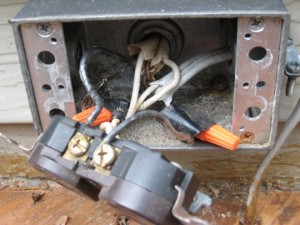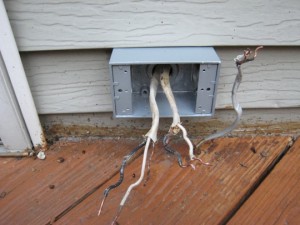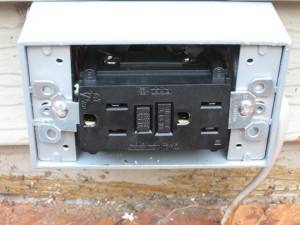
 I finally got around to installing a ground fault circuit interrupter (GFCI) on my deck. The prior owners had a regular receptacle which worked about 50% of the time. A soft kick usually got it working. This was obviously something that needed a little more attention.
I finally got around to installing a ground fault circuit interrupter (GFCI) on my deck. The prior owners had a regular receptacle which worked about 50% of the time. A soft kick usually got it working. This was obviously something that needed a little more attention.
How GFCI’s Work
A GFCI is a device used to protect against electrical current. It does this by measuring the imbalance of current between the hot and neutral conductors of a circuit. Typically, the two currents are about the same. When the difference becomes greater than 5mA, the circuit is de-energized. This can happen when, say, current passes through a person to the ground.
Wiring a GFCI
 GFCI’s are good safety devices but only if wired appropriately. When you examine a GFCI you will see at least one pair of terminals marked “Line” and another pair marked as “Load”. The Line terminals are for incoming power from the breaker. The Load terminals are for powering other receptacles downstream. Be sure to shut off power to the circuit before handling the wires.
GFCI’s are good safety devices but only if wired appropriately. When you examine a GFCI you will see at least one pair of terminals marked “Line” and another pair marked as “Load”. The Line terminals are for incoming power from the breaker. The Load terminals are for powering other receptacles downstream. Be sure to shut off power to the circuit before handling the wires.
I determined which wire was coming from the breaker in this fashion. After removing the old receptacle and separating the wires, I turned the breaker back on and carefully tested each pair to determine which wire was active. Then I turned the breaker off and continued.
Connect the incoming power, black wire to the hot Line terminal and connect the incoming power, white wire to the neutral Line terminal.
In a similar fashion, connect the downstream power, black wire to the hot Load terminal and downstream power, white wire to the neutral Load terminal.
Splice ground wires together and connect to the green screw on the GFCI.
Testing Your GFCI
You want to be sure that everything is working appropriately. Here are scenarios that I tested:
- With the breaker off, there should be no power
- With the breaker on, and the “reset” button pressed, your receptacle (and everything downstream) should have power
- With the breaker on, and the “test” button pressed, your receptacle (and everything downstream) should not have power
I’ve found a professional multimeter to be a must have for working with my home electric. A multimeter is the only reliable way I can know which wires are hot. I use it constantly.
If your interested in a more complete electric guide. Check out Freds review of Stanley’s Complete Wiring Manual.
What do you think? How often do you test your GFCI’s? Ever replaced one?






